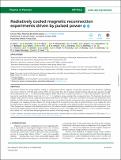Radiatively cooled magnetic reconnection experiments driven by pulsed power
Author(s)
Datta, R.; Chandler, K.; Myers, C. E.; Chittenden, J. P.; Crilly, A. J.; Aragon, C.; Ampleford, D. J.; Banasek, J. T.; Edens, A.; Fox, W. R.; Hansen, S. B.; Harding, E. C.; Jennings, C. A.; Ji, H.; Kuranz, C. C.; Lebedev, S. V.; Looker, Q.; Patel, S. G.; Porwitzky, A.; Shipley, G. A.; Uzdensky, D. A.; Yager-Elorriaga, D. A.; Hare, J. D.; ... Show more Show less
Download052110_1_5.0201683.pdf (8.060Mb)
Publisher with Creative Commons License
Publisher with Creative Commons License
Creative Commons Attribution
Terms of use
Metadata
Show full item recordAbstract
We present evidence for strong radiative cooling in a pulsed-power-driven magnetic reconnection experiment. Two aluminum exploding wire arrays, driven by a 20 MA peak current, 300 ns rise time pulse from the Z machine (Sandia National Laboratories), generate strongly driven plasma flows (
) with anti-parallel magnetic fields, which form a reconnection layer (
) at the mid-plane. The net cooling rate far exceeds the Alfvénic transit rate (
), leading to strong cooling of the reconnection layer. We determine the advected magnetic field and flow velocity using inductive probes positioned in the inflow to the layer, and inflow ion density and temperature from analysis of visible emission spectroscopy. A sharp decrease in x-ray emission from the reconnection layer, measured using filtered diodes and time-gated x-ray imaging, provides evidence for strong cooling of the reconnection layer after its initial formation. X-ray images also show localized hotspots, regions of strong x-ray emission, with velocities comparable to the expected outflow velocity from the reconnection layer. These hotspots are consistent with plasmoids observed in 3D radiative resistive magnetohydrodynamic simulations of the experiment. X-ray spectroscopy further indicates that the hotspots have a temperature (170 eV) much higher than the bulk layer (
) and inflow temperatures (about
) and that these hotspots generate the majority of the high-energy (
) emission.
Date issued
2024-05-01Department
Massachusetts Institute of Technology. Plasma Science and Fusion CenterJournal
Physics of Plasmas
Publisher
AIP Publishing
Citation
R. Datta, K. Chandler, C. E. Myers, J. P. Chittenden, A. J. Crilly, C. Aragon, D. J. Ampleford, J. T. Banasek, A. Edens, W. R. Fox, S. B. Hansen, E. C. Harding, C. A. Jennings, H. Ji, C. C. Kuranz, S. V. Lebedev, Q. Looker, S. G. Patel, A. Porwitzky, G. A. Shipley, D. A. Uzdensky, D. A. Yager-Elorriaga, J. D. Hare; Radiatively cooled magnetic reconnection experiments driven by pulsed power. Phys. Plasmas 1 May 2024; 31 (5): 052110.
Version: Final published version
ISSN
1070-664X
1089-7674